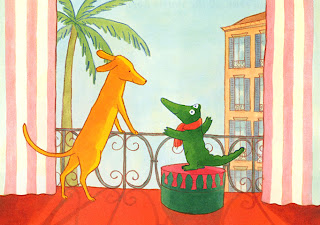Matilda
1.What
do you like most about the character?
Matilda
is very independent character who is able to outwit the bad characters through
intelligence and a little bit of supernatural powers. She is a bookworm and
enjoys learning, as a child I really enjoyed reading about a character who was
smart and wanted to go to school, as I enjoyed school.
2.How
do they make you feel?
She
makes it feel like through learning there are limitless possibilities available
which is inspiring. As a child you can feel helpless, so it is good to read
about a character who is able to do something about the bad characters
3.How
is colour, line, form and mark making used?
They
are very child-like drawings, which bring Matilda down to a realistic and
relatable level to the child. Colour is only used on the cover, inside is ink
drawings.
4.Ways
in which you identify with the character e.g. Rebel, leader, Outsider, Victim,
Overcoming Evil?
I’m
the only one in my family that actually reads book so I found this relatable,
and being a bit of an outsider because I liked to go to school to learn. I
would have liked to be more rebellious in the way Matilda gets her own back
when people are mean to her, as a child sometimes you know you’re in the right but adults are
convinced otherwise.
5.What
are the themes with which they are usually associated e.g. adventure,
overcoming evil?
Matilda
learnt to do everything herself so her independence is a continuing theme from
learning to cook and read, when she is left at home, to walking to the library
by herself when she runs out of books. She also believes in righting, wrong
behaviour the only way she knows how, which is mischievous and comically witty.
6.
What medium/media have been used?
Ink
and dip pen drawing which he then adds watercolour for the colour images
7.About
the narrative (what’s happening in your image)?
The
front cover image of Matilda shows her standing on top of several books,
emphasizing how small she is, also representing either she has read or will
read all those books. The children in the background are celebrating; throwing
books in the air is something other children may do but not Matilda. This makes
the book inviting, you would want to know why the children are celebrating.
8.What
are the relationships between the characters?
Matilda’s
family are detached from their daughter, and find her weird. Trunchball, the
Headmistress dislikes everybody especially children and evokes fear from all
the other characters. Miss Honey is the lovable character that all the children
love; Matilda and Miss Honey develop a caring relationship, which eventually
results in an adopted mother-daughter relationship.
9.Does
the illustrators interpretations of the character fit with the character
described in the text?
Quentin
draws Matilda very tiny and small in relation to objects around her to
emphasize this, but she is able to rise above this in an adults world.





















































